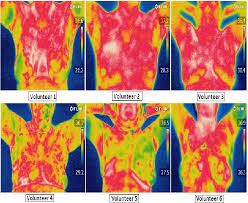Breast cancer remains one of the most prevalent cancers among women worldwide. Early detection is crucial for improving treatment outcomes and survival rates. Various imaging techniques are employed in the screening and diagnosis of breast cancer, with ultrasonograms, mammograms, and thermograms being among the most widely used. Each of these tools plays a distinct role in the detection, diagnosis, and monitoring of breast cancer.

- Ultrasonogram (Ultrasound)
What is it?
An ultrasonogram, or ultrasound, uses sound waves to create images of the internal structures of the body. It is particularly useful in assessing breast tissue.
Role in Breast Cancer:
– Initial Assessment: Ultrasound is often used as a follow-up to mammography, especially in women with dense breast tissue where mammograms may not provide clear images.
– Guided Biopsies: Ultrasound can help guide needle biopsies, allowing doctors to accurately target abnormal areas for tissue sampling.
– Evaluation of Masses: It differentiates between solid masses (which may be cancerous) and cysts (which are typically benign).
– Monitoring: Ultrasound is useful in monitoring the size and characteristics of known tumors over time, aiding in treatment evaluation.
Advantages:
– No ionizing radiation.
– Real-time imaging allows for dynamic assessment.
– Particularly helpful in younger women and those with denser breast tissue.
- Mammogram
What is it?
A mammogram is an X-ray of the breast and is considered the gold standard for breast cancer screening.
Role in Breast Cancer:

– Screening Tool: Regular mammograms can detect breast cancer at an early stage, often before symptoms appear. The American Cancer Society recommends annual mammograms for women starting at age 40.
– Detection of Microcalcifications: Mammograms can identify tiny deposits of calcium in the breast tissue, which can indicate the presence of breast cancer.
– Assessing Changes: If a woman presents with symptoms or a lump, a diagnostic mammogram can help evaluate these changes in detail.
Advantages:
– Proven efficacy in reducing breast cancer mortality.
– Standardized procedure with established guidelines and protocols.
– High sensitivity for detecting small tumors.
- Thermogram (Thermal Imaging)
What is it?
Thermography, or thermal imaging, is a non-invasive technique that detects heat patterns and blood flow in breast tissue using infrared cameras.
Role in Breast Cancer:
 – Early Detection: Thermograms can identify areas of increased heat that may indicate abnormal metabolic activity often associated with cancer.
– Early Detection: Thermograms can identify areas of increased heat that may indicate abnormal metabolic activity often associated with cancer.
– Complementary Tool: While not a replacement for mammography or ultrasound, thermography can serve as an additional screening method, particularly for women who are concerned about radiation exposure.
– Monitoring Treatment Response: Changes in thermal patterns may help assess how well a treatment is working.
Advantages:
– No radiation exposure.
– Pain-free and non-invasive.
– Potential to identify physiological changes associated with cancer.
Integrative Approach to Breast Cancer Detection and Treatment
Each imaging modality plays a unique role in the continuum of breast cancer care, from initial screening to diagnosis and treatment monitoring. An integrative approach, combining these tools, can enhance the accuracy of breast cancer detection and improve patient outcomes.
Combined Use of Imaging Techniques
– Mammogram First: Mammograms are typically the first step in breast cancer screening. If abnormalities are detected, further assessment with ultrasound or thermography may be warranted.
– Ultrasound as a Supplement: In cases of dense breast tissue or if a mammogram shows suspicious findings, ultrasound is often used for clarification.
– Thermography as an Adjunct: While thermography is not widely endorsed as a primary screening tool, it can be considered in conjunction with other modalities, particularly for monitoring and assessing treatment responses.
Conclusion
Ultrasonograms, mammograms, and thermograms each play a vital role in the screening, diagnosis, and monitoring of breast cancer. Their combined use enhances the overall effectiveness of breast cancer detection strategies, paving the way for timely intervention and improved patient outcomes. As technology advances, continued research and clinical trials will further define and optimize the roles of these imaging techniques in breast cancer management, ensuring that women receive the most accurate and effective care possible.

